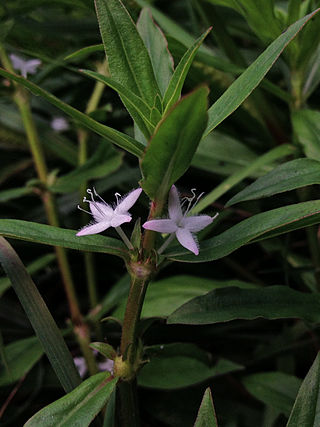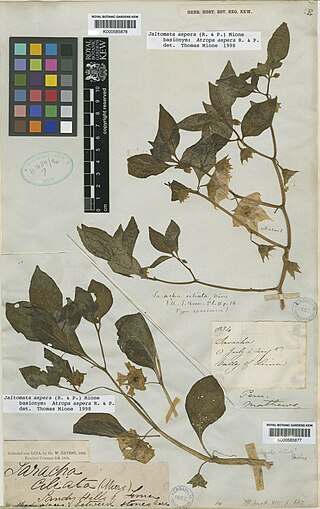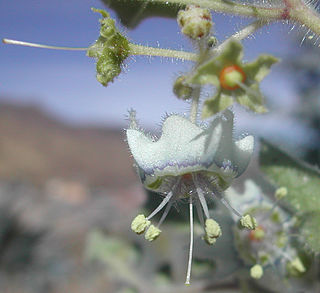
Diodia is a genus of flowering plants in the family Rubiaceae. It was described by Carl Linnaeus in 1753. The genus is found from southern and eastern United States, South America, Central America, Mexico, the West Indies and tropical Africa.

Hentzia is a genus of the spider family Salticidae subfamily Dendryphantinae. The genus is widespread in North America and northern South America but the center of biodiversity seems to be primarily in the Caribbean and surrounding areas, with the greatest species diversity occurring in Cuba, which has seven species. Some outlier species, such as Hentzia poenitens and Hentzia fimbriata are found in western North America. It appears to be closely related to the genus Anicius from which it differs primarily in certain anatomical details.

Hohenbergia is a genus of plants in the family Bromeliaceae, subfamily Bromelioideae. It is native to the West Indies, the Yucatán Peninsula, and northern South America.

Solanum bahamense, commonly known as the Bahama nightshade, is a plant in the nightshade family. It is native across the West Indies, from the Florida Keys east to Dominica. It is a common species in coastal habitats, often on calcareous soils.
Basiphyllaea is a genus of orchids, known as Carter's orchid or crab orchids. They are native to Florida and the West Indies. At the present time, 7 species are recognized:

Oncidium altissimum, Wydler's dancing-lady orchid, is a species of orchid native to the West Indies, with an 18th-Century citation from Jamaica.

Lasiacis (smallcane) is a genus of Neotropical plants in the grass family, found in the Americas from Mexico and Florida south to Argentina.

Sphagneticola is a genus of flowering plants in the family Asteraceae. Creeping-oxeye is a common name for plants in this genus.

Catesbaea is a genus of flowering plants in the family Rubiaceae. It occurs in the West Indies, The Bahamas, and the Florida Keys. The genus is named in honour of English naturalist Mark Catesby.

Solanum diphyllum, commonly known as the twoleaf nightshade, is a species of nightshade native to the Americas. It is cultivated as an ornamental plant for its clusters of dark green round fruits that turn a bright yellow when ripe.

Jaltomata is a genus of plants in the family Solanaceae. According to molecular phylogenies, Jaltomata is the sister genus to Solanum, which includes tomato, potato, and eggplant. Jaltomata has a neotropical distribution, in that species occur from the United States southwest through Latin America, and into the Andean region of South America. Species encompass a wide range of vegetative and reproductive trait variation, including growth habit, floral size, shape and color, as well as fruit size and color. The fruits of some of the species are eaten by humans in Latin and South America. Depending on the species, fruits may be red, green, orange, or dark purple.

Jaltomata procumbens, the creeping false holly, is a plant species native to Arizona, USA, Mexico, Central America, Colombia, Ecuador, and Venezuela. It grows as a weed in agricultural fields and other disturbed locations, but in many places the people protect it because of the edible fruits it produces.

Jaltomata aspera is a plant species native to Peru. It grows on rocky hillsides at elevations less than 1800 m.

Jaltomata weberbaueri is a plant species native to Peru. It grows on rocky hillsides at elevations less than 1800 m.
Jaltomata cuyasensis is a plant species native to Peru. It grows on rocky hillsides at elevations less than 1800 m.
Jaltomata werffii is a plant species endemic to the Galápagos Islands in Ecuador. The epithet was spelled "werfii" in the original publication, but was corrected to "werffii" later, per Article 60.1 of the Code. The single "f" was a typographical error, as the plant was named in honor of Henk van der Werff.

Jaltomata grandiflora is a rare plant species native to the Mexican State of Michoacán.

Jaltomata lojae is a plant species native to Peru and Ecuador.

Vallesia is a genus of plants in the family Apocynaceae first described as a genus in 1794. It is native to South America, Central America, Mexico, Florida, Galápagos, and the West Indies.

Jaltomata cajacayensis is a plant species native to Peru. The name comes from the Cajacay District, where it was recognized by Mione as a new species.
















